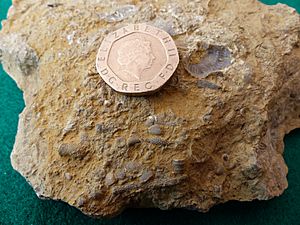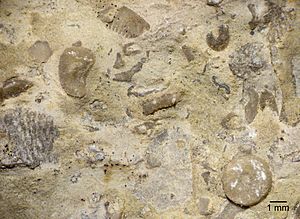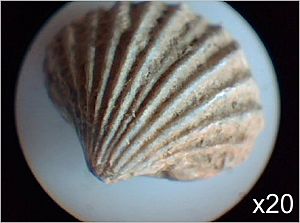Wren's Nest facts for kids
Quick facts for kids Wren's Nest |
|
|---|---|
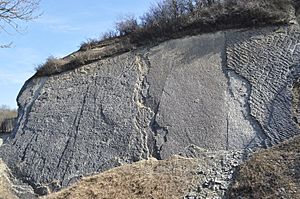
Fossilized ripple markings at Wren's Nest
|
|
| Lua error in Module:Location_map at line 420: attempt to index field 'wikibase' (a nil value). | |
| Type | Nature reserve |
| Location | Dudley, West Midlands, England |
| OS grid | SO937921 |
| Created | 1956 |
| Operated by | Dudley Metropolitan Borough Council |
| Open | All year |
The Wren's Nest is an amazing natural area in Dudley, England. It is known around the world for its special rocks and fossils. This place is so important that it's protected as a Site of Special Scientific Interest, a Local Nature Reserve, and a National Nature Reserve. It's even a Scheduled Ancient Monument, which means it's a very old and important historical site.
The Wren's Nest is also home to many different kinds of birds. You can also find some rare plants here, like Small Scabious, Milkwort, and Quaking Grass. The caves at Wren's Nest are super important for seven different types of bats. These bats use the caves to hibernate, which means they sleep through the winter.
Contents
Discovering the Wren's Nest National Nature Reserve
Ancient Sea Life and Fossils
The Wren's Nest National Nature Reserve is famous for its incredible Silurian coral reef fossils. These fossils are extremely well-preserved. Scientists say it's the best place in the British Isles to find so many different kinds of fossils.
More than 700 types of fossils have been discovered here. Eighty-six of these types are found nowhere else in the world! One of the most famous fossils is Calymene blumenbachii, a type of trilobite. Quarry workers in the 1700s called it the Dudley Bug or Dudley Locust. This trilobite was even on Dudley's town coat of arms until 1974.
The limestone rocks you see at Wren's Nest are part of something called the Wenlock Group. These rocks formed about 420 to 425 million years ago. They were once the bottom of an ancient tropical sea. You can even see ripple marks in the rocks, which were made by the sea's waves on the sand long, long ago.
Wren's Nest During the Industrial Revolution
The Wren's Nest area played a big part in the Industrial Revolution. A very important person named Abraham Darby I was born on Wren's Nest Hill in 1678. He helped start the Industrial Revolution.
For hundreds of years, people mined the caves at Wren's Nest for valuable limestone. This limestone was first used for building and farming. Later, it became super important for making iron during the Industrial Revolution. The Victorians even put the world's first industrial steam engine next to Wren's Nest. This engine helped pump water out of the mines and tunnels.
At the peak of the Industrial Revolution, people dug out up to 20,000 tons of limestone every year! The area around Wren's Nest, known as the Black Country, was a very busy industrial place back then. Mining officially stopped in 1925, and the site was left empty.
Wren's Nest in Modern Times
In 1956, Wren's Nest was officially made a National Nature Reserve. It was the very first national nature reserve in the UK specifically for geology, which is the study of rocks and the Earth.
In 2004, Wren's Nest and the nearby Castle Hill were named Scheduled Ancient Monuments. This was because they are the best remaining examples of the limestone mining industry in Dudley. One of the most amazing parts is the Seven Sisters. This is the last remaining limestone cavern that opens to the surface in the world. It used to go more than 100 meters underground! The old mine tunnels were once connected to the Dudley Tunnel by an underground canal, but this path is now blocked for safety.
A Scottish scientist named Sir Roderick Murchison first realized how important Wren's Nest's geology was in 1839. Today, scientists from all over the world still visit the old quarry and tunnels to study their valuable rocks and fossils.
The Seven Sisters Tunnel Complex
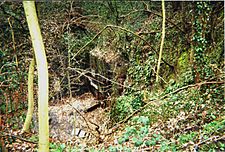
The Seven Sisters caverns are a great example of old limestone mining. However, parts of them had to be filled in after a big roof collapse in 2001. This was done to stop more parts from falling in. More recently, work also started to fill the huge Cathedral Gallery with sand.
The old limestone mine and the large underground canal basin next to it are very important. Local historians say they hold some of the world's most important geology and mining history. The canal basin used to lead to a passage to the Dudley Tunnel, but this path is now blocked.
In 2007, Dudley Council tried to get a £50,000,000 grant to fix up and reopen the caverns. They didn't get that big grant, but they did get £800,000 from the Heritage Lottery Fund. This money helped make smaller improvements to the site.



